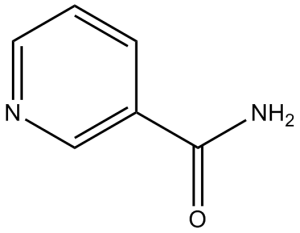Nicotinamide (Vitamin B3)
This product is for research use only, not for human use. We do not sell to patients.

For small sizes, please check our retail website as below: www.invivochem.com
| Size | Price | Stock |
|---|---|---|
| 25g | $295 | Check With Us |
| 50g | $515 | Check With Us |
| 100g | $770 | Check With Us |
Cat #: V0432 CAS #: 98-92-0 Purity ≥ 98%
Description: Nicotinamide (Vitamin B3; Niacinamide; Nicotinic acid amide), a water-soluble and active form of vitamin B3, is a potent and active component of coenzymes NAD and NADP.
Top Publications Citing Invivochem Products
Publications Citing InvivoChem Products
Product Promise

- Physicochemical and Storage Information
- Protocol
- Related Biological Data
- Stock Solution Preparation
- Quality Control Documentation
| Molecular Weight (MW) | 122.12 |
|---|---|
| Molecular Formula | C6H6N2O |
| CAS No. | 98-92-0 |
| Storage | -20℃ for 3 years in powder formr |
| -80℃ for 2 years in solvent | |
| Solubility In Vitro | DMSO: 24 mg/mL (196.52 mM)r |
| Water: 24 mg/mL (196.52 mM)r | |
| Ethanol: 24 mg/mL (196.52 mM) | |
| Synonyms | Niacinamide, Vitamin PP, Nicotinic acid amide; Vitamin B3 |
| Protocol | In Vitro | Nicotinamide (0.01-20 mM, 1 h) inhibits purified SIRT2 enzymatic activity in vitro with an EC50 of 2 μM. Nicotinamide (0.01-20 mM, 1 h) inhibits purified SIRT2 enzymatic activity in vitro with an EC50 of 2 μM. Nicotinamide (10-50 mM, 24 h ) makes A375 cells undergo accumulation in G1 phase, reduction in S phase, and increase inthe sub-G1 (apoptosis) phase. Nicotinamide (10-50 mM, 24 h ) makes A375 cells undergo accumulation in G1 phase, reduction in S phase, and increase inthe sub-G1 (apoptosis) phase. |
|---|---|---|
| In Vivo | Nicotinamide (10-50 mM, 24 h ) makes A375 cells undergo accumulation in G1 phase, reduction in S phase, and increase inthe sub-G1 (apoptosis) phase. Nicotinamide (10-50 mM, 24 h ) makes A375 cells undergo accumulation in G1 phase, reduction in S phase, and increase inthe sub-G1 (apoptosis) phase. |
These protocols are for reference only. InvivoChem does not
independently validate these methods.
| Solvent volume to be added | Mass (the weight of a compound) | |||
|---|---|---|---|---|
| Mother liquor concentration | 1mg | 5mg | 10mg | 20mg |
| 1mM | 8.1887 mL | 40.9433 mL | 81.8867 mL | 163.7733 mL |
| 5mM | 1.6377 mL | 8.1887 mL | 16.3773 mL | 32.7547 mL |
| 10mM | 0.8189 mL | 4.0943 mL | 8.1887 mL | 16.3773 mL |
| 20mM | 0.4094 mL | 2.0472 mL | 4.0943 mL | 8.1887 mL |
| Quality Control Documentation |
|
|---|
The molarity calculator equation
Mass(g) = Concentration(mol/L) × Volume(L) × Molecular Weight(g/mol)
Mass
=
Concentration
×
Volume
×
Molecular Weight*
The dilution calculator equation
Concentration(start)
×
Volume(start)
=
Concentration(final)
×
Volume(final)
This equation is commonly abbreviated as: C1 V1 = C2 V2
Concentration(start)
C1
×
Volume(start)
V1
=
Concentration(final)
C2
×
Volume(final)
V2
Step One: Enter information below
Dosage mg/kg
Average weight of animals g
Dosing volume per animal µL
Number of animals
Step Two: Enter the in vivo formulation
%DMSO
+
%
+
%Tween 80
+
%ddH2O
Calculation Results:
Working concentration:
mg/ml;
Method for preparing DMSO master liquid:
mg
drug pre-dissolved in
µL
DMSO(Master liquid concentration
mg/mL)
,Please contact us first if the concentration exceeds the DMSO solubility of the batch of drug.
Method for preparing in vivo formulation:
Take
µL
DMSO master liquid, next add
µL
PEG300, mix and clarify, next add
µL
Tween 80,mix and clarify, next add
µL
ddH2O,mix and clarify.
Note:
- (1) Please be sure that the solution is clear before the addition of next solvent. Dissolution methods like vortex, ultrasound or warming and heat may be used to aid dissolving.
- (2) Be sure to add the solvent(s) in order.




































